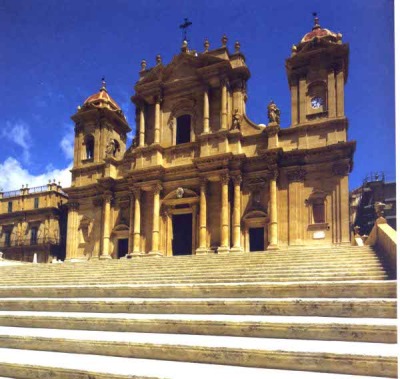Home - In and around
MOTHER CHURCH OF SAN NICOL̉ IN NOTO SICILY
The Mother Church of San Nicoḷ in Noto is also the cathedral of the city, as the main church of the diocese of Noto. The church is dedicated to St. Nicholas.
History
The construction of the grandiose baroque basilica began in the early eighteenth century, following the post-earthquake reconstruction of 1693. The precious monument was then completed in 1776, although in the following centuries various reconstructions and modifications were made, such as the decoration of the nave central and apse with frescoes by N. Arduino in the early fifties of the twentieth century and the replacement, again in the fifties, of the original pitched roof of the central nave with a heavy concrete floor that was probably one of the secondary causes of the collapse of 1996.
The collapse of 1996 and reconstruction
Following the earthquake of December 13, 1990, the church suffered structural damage and even then it was decided to close it to worship and submit it to restoration. However, there was no time to take such measures.
On the evening of March 13, 1996, due to a serious constructive defect (never noticed before) of the pillars of the central nave (filled with river stones instead of squared stone blocks), one of the pylons on the right of the basilica ruined the ground, dragging with it the whole right aisle, the central nave, the right transept, the triumphal arch and finally the dome, of which only a small part of the drum remained miraculously standing. Fortunately there were no victims, because at that time the church was not open to the public.
After the devastating collapse, what had once been Noto's most beautiful jewel seemed inexorably lost. In January 2000, after a first phase of clearing the rubble, restoration work began. Initially the new pillars on the right were rebuilt, preserving the shape and features of the original ones, but without the defect that had decreed the collapse of the basilica. Then we moved on to the demolition and subsequent reconstruction of the pillars of the left aisle, which reported the same serious imperfections as those collapsed. Subsequently the central nave, the right aisle, the right-hand cupolas, the buttresses, the transverse and longitudinal arches have returned to their former splendor. The last chapter of the reconstruction of the Cathedral was the raising of the new dome, almost identical to the original: it differs only from very small corrections, such as the thickening of a few millimeters of the base of the drum. The new roof of the church is not concrete like the collapsed one (dating back to the fifties of the twentieth century), but rather like the original one.
The reconstruction was performed with the same materials and with the help of the same techniques of the eighteenth century. Local stones were used such as white calcarenite, sandstone and Modica stone, but assembled using modern anti-seismic methods. In order to improve resistance to strong earthquakes, materials such as carbon fiber have also been used.
At the end of this long and complex restoration, the church was reopened after seven years of work on June 18, 2007. At the solemn ceremony were present, among others, Cardinal Giovanni Battista Re, prefect of the Congregation for Bishops, Msgr. Angelo Bagnasco, president of the CEI and archbishop of Genoa, the President of the Council Romano Prodi, the president of the Sicilian Region Salvatore Cuffaro, the head of the Civil Defense Guido Bertolaso, the art critic Vittorio Sgarbi (who is part of the commission assigned to the restoration of furnishings and decorations inside the Cathedral) and other important institutional and religious offices from all over Sicily and from other regions of Italy.
Now we are working on the recovery of the pictorial decoration, which began with the dome. In the summer of 2009 we work with the plumes.
History
The construction of the grandiose baroque basilica began in the early eighteenth century, following the post-earthquake reconstruction of 1693. The precious monument was then completed in 1776, although in the following centuries various reconstructions and modifications were made, such as the decoration of the nave central and apse with frescoes by N. Arduino in the early fifties of the twentieth century and the replacement, again in the fifties, of the original pitched roof of the central nave with a heavy concrete floor that was probably one of the secondary causes of the collapse of 1996.
The collapse of 1996 and reconstruction
Following the earthquake of December 13, 1990, the church suffered structural damage and even then it was decided to close it to worship and submit it to restoration. However, there was no time to take such measures.
On the evening of March 13, 1996, due to a serious constructive defect (never noticed before) of the pillars of the central nave (filled with river stones instead of squared stone blocks), one of the pylons on the right of the basilica ruined the ground, dragging with it the whole right aisle, the central nave, the right transept, the triumphal arch and finally the dome, of which only a small part of the drum remained miraculously standing. Fortunately there were no victims, because at that time the church was not open to the public.
After the devastating collapse, what had once been Noto's most beautiful jewel seemed inexorably lost. In January 2000, after a first phase of clearing the rubble, restoration work began. Initially the new pillars on the right were rebuilt, preserving the shape and features of the original ones, but without the defect that had decreed the collapse of the basilica. Then we moved on to the demolition and subsequent reconstruction of the pillars of the left aisle, which reported the same serious imperfections as those collapsed. Subsequently the central nave, the right aisle, the right-hand cupolas, the buttresses, the transverse and longitudinal arches have returned to their former splendor. The last chapter of the reconstruction of the Cathedral was the raising of the new dome, almost identical to the original: it differs only from very small corrections, such as the thickening of a few millimeters of the base of the drum. The new roof of the church is not concrete like the collapsed one (dating back to the fifties of the twentieth century), but rather like the original one.
The reconstruction was performed with the same materials and with the help of the same techniques of the eighteenth century. Local stones were used such as white calcarenite, sandstone and Modica stone, but assembled using modern anti-seismic methods. In order to improve resistance to strong earthquakes, materials such as carbon fiber have also been used.
At the end of this long and complex restoration, the church was reopened after seven years of work on June 18, 2007. At the solemn ceremony were present, among others, Cardinal Giovanni Battista Re, prefect of the Congregation for Bishops, Msgr. Angelo Bagnasco, president of the CEI and archbishop of Genoa, the President of the Council Romano Prodi, the president of the Sicilian Region Salvatore Cuffaro, the head of the Civil Defense Guido Bertolaso, the art critic Vittorio Sgarbi (who is part of the commission assigned to the restoration of furnishings and decorations inside the Cathedral) and other important institutional and religious offices from all over Sicily and from other regions of Italy.
Now we are working on the recovery of the pictorial decoration, which began with the dome. In the summer of 2009 we work with the plumes.



